February 19, 2019
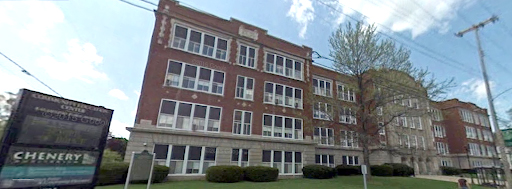
Nestled on the fourth floor of Kalamazoo Public Schools’ Community Education Center, home to the historic Chenery Auditorium, you’ll find the Kalamazoo Area Mathematics and Science Center, better known as KAMSC to the students and families of Kalamazoo County.
KAMSC provides an accelerated academic program designed for students with a passion to excel in the fields of mathematics, the sciences and computer science, and to engage in a research agenda throughout high school. KAMSC’s high school program serves approximately 300 talented students selected from the nine area school districts in Kalamazoo County.
I had the pleasure of joining former student McKinzie Ervin, a pre-med student at Kalamazoo College, and KAMSC director Dr. Michael Tanoff on a visit. Dr. Tanoff joined the KAMSC team as Director in August of 2011. He holds a bachelor’s degree in chemical engineering from Rutgers University and a Ph.D. in engineering and applied science from Yale University.
KAMSC was founded in 1986 with the idea that a program like this would entice potential Upjohn employees to settle in the Kalamazoo area. Kalamazoo Public Schools serves as KAMSC’s administrative and fiscal agent. The KAMSC Executive Council, made up of superintendents of the nine public school districts of KRESA, as well as the KRESA superintendent, set the fiscal and administrative policies.
KAMSC is a highly selective program that admits students based on admission test scores, teacher recommendations, writing samples and grades. Each year, more than 250 students complete the application process to compete for approximately 85 seats in the ninth-grade class.
Students attend KAMSC for half of their school day and their district, private, parochial or home high school for the other half. Their challenging courses emphasize problem solving and research skills throughout the four-year program. The program is laboratory intensive, providing opportunities to apply theoretical foundations to experimental situations.
Outside of class, students take advantage of research, competitions and team projects in STEM fields. Each year, more than 30 students conduct independent research in the community with mentors from business, industry and academia. They present their research at the Southwest Michigan Science and Engineering Fair, and regional winners present at the INTEL International Science and Engineering Fair.
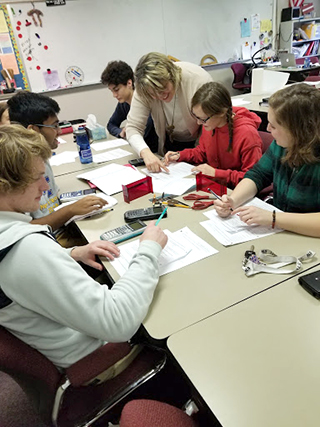
My first classroom visit was to Mrs. Kalnins’ AP Statistics class. Mrs. Kalnins is a National Board Certified Teacher and has been teaching at KAMSC since 1993. When asked about what makes the mathematics program at KAMSC different from other HS programs, she pointed out that KAMSC works on horizontal enrichment – project-based learning, discovery-oriented learning and investigative instruction – rather than simply providing an accelerated curriculum.
The content is integrated in the students’ coursework at KAMSC. Mrs. Kalnins pointed out that students are not only using statistics in her AP Stats class, but statistics are used in context in science, in the research programs and more. The staff at KAMSC work closely to develop this cross-curricular programming.
Next, I visited Ms. Hach’s AP Environmental Science class. This is Ms. Hach’s 29th year of teaching, and she is also a National Board Certified Teacher. Her goal is to create better scientific citizens with a broad understanding about how the world operates.
She helps develop students who care about math and care about science. She points out that the students at KAMSC want to be here, and they want their learning to be relevant. This is one of the reasons why she uses a flipped classroom model for her science instruction.
Generally, students read and study the content at home. Then, they apply their new learning in a project-based environment in the classroom. On the day that I visited, students were using “street fighting math.” This is based on the idea that nobody wants the actual number, but just a ballpark figure when it comes to complex calculations in real-life situations. Students were solving problems surrounding the amount of CO2 in the atmosphere, the environmental and financial cost of real vs. artificial Christmas trees, the amount of napkins used annually and more. Ms. Hach says, “I give the students a lot of yarn, but they have to knit the sweater.”
At KAMSC, chemistry doesn’t stay in chemistry class, and biology doesn’t stay in biology class. The math and science courses are interwoven. In Ms. Hach’s environmental science class, the students are immersed in projects related to genetics, calculus, statistics, chemistry, biology and more. The students solve complex mathematics and science problems in cooperative groups and then share out their findings to the class.
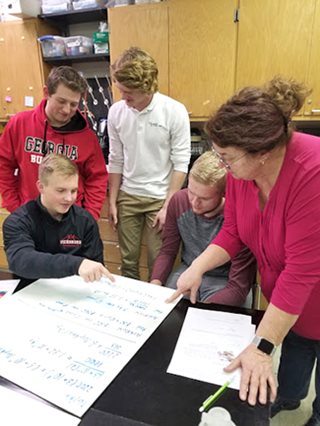
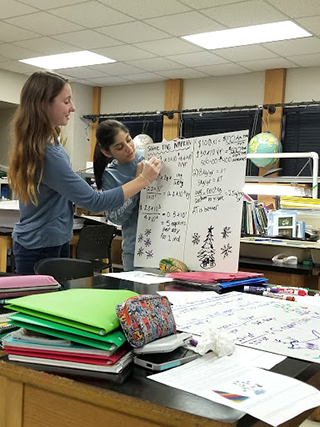
Dr. Tanoff pointed out that science is conveying information ... not just learning the information, but discourse – going public – being able to present to colleagues and receive criticism. This is what the students do daily in these courses.
Mr. Sinclair, known for his engaging discussions, for his excitement for teaching and for donning a full-length lab coat daily, has been with KAMSC since 1988 and also is a National Board Certified Teacher.
Students were learning about the physics of the movie “Interstellar.” The “Physics student of the week” sitting in the recliner, had been recognized in class for going above and beyond, showing extra effort and seeking out additional learning opportunities.
The passion for physics just flows out of Mr. Sinclair. Students were completely engaged in this interactive discussion, taking notes while Mr. Sinclair provided relevant explanations. He seamlessly moved between the movie Interstellar and the physics content, always making the high-level content accessible to the students. He incorporated movie scenes to reinforce concepts, shared research and asked probing questions. The students’ questions to Mr. Sinclair showed their deep level of content understanding, as well.
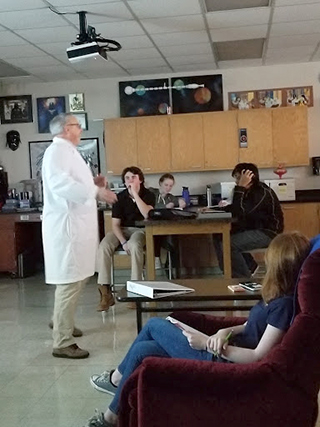
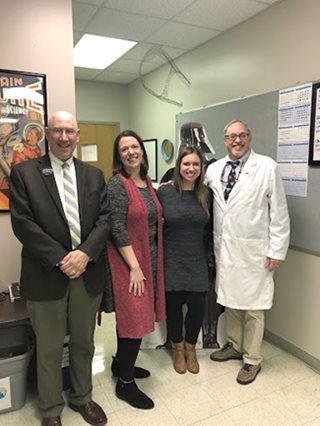
I saw many kinds of instruction at KAMSC: engaging lectures with students taking notes, students solving problems in small groups to apply content previously learned, collaborative learning with students solving problems and presenting information to the class with students engaging in high-level academic discussion and debate about their solutions.
Although I witnessed a variety of instructional approaches, such as small group instruction, student-led learning and teacher-led discussions, one thing was consistent in each classroom. Students were engaged in the learning. Students were asking deep questions about the content. Students were making connections from one class to another. Students were working cooperatively with classmates to solve problems and deepen their understanding. Students were sharing their findings with their classmates and were seeking feedback from peers to guide their learning.
The student commons area at KAMSC showcases pennants from the hundreds of universities in which these students have continued their education. While a significant number of students have chosen the University of Michigan, also represented are Ivy League schools, military academies and other top-ranked universities.
I was fortunate to talk with many students during my visit to KAMSC. A theme quickly emerged during these discussions. The students all mentioned that the people and atmosphere are what keep them at KAMSC, with many commenting on the family-feel environment. They pointed out that everyone at KAMSC is invested in their learning, and there is an atmosphere of collaboration where they are all learning together. They noted that the teachers are invested in their learning, are especially passionate about what they teach and are enthusiastic while making the subjects come alive. They appreciate that the teachers treat them like adults and believe in each of them.
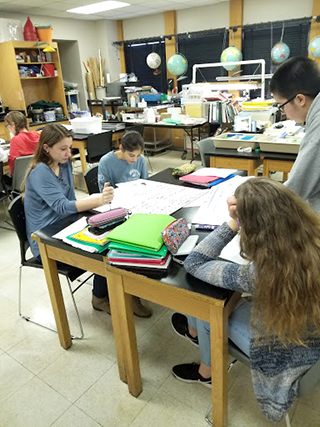
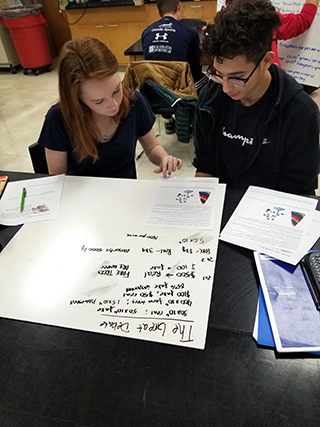
One student mentioned that the teachers “put a lot of faith in us and have higher expectations for us than any other teacher in my school career.” She pointed out that students develop strong relationships with their teachers, and teachers are always available after hours to provide additional support for the rigorous content. It is obvious that the teachers of KAMSC truly care about the students’ success. They offer individual attention. Students are closely monitored and are sought out for extra work after class, when necessary. There is an expectation that students will work hard, will try their best and will succeed.
Another student mentioned that she came to KAMSC to pursue a career in STEM, but she stayed because of the relationships and collaboration.
KAMSC is one outstanding example of an accelerated academic program in Kalamazoo County designed for students to excel in various fields. Please share the types of programs your area offers to meet the needs of students with exceptional academic abilities. I would love to connect!
 Laura Chang is Michigan’s Teacher of the Year for 2018-19, and Meemic is proud to partner with the Michigan Department of Education for the program. Laura is entering her nineteenth year of teaching at Sunset Lake Elementary in Vicksburg Community Schools, where she is currently a K-5 interventionist.
Laura Chang is Michigan’s Teacher of the Year for 2018-19, and Meemic is proud to partner with the Michigan Department of Education for the program. Laura is entering her nineteenth year of teaching at Sunset Lake Elementary in Vicksburg Community Schools, where she is currently a K-5 interventionist.